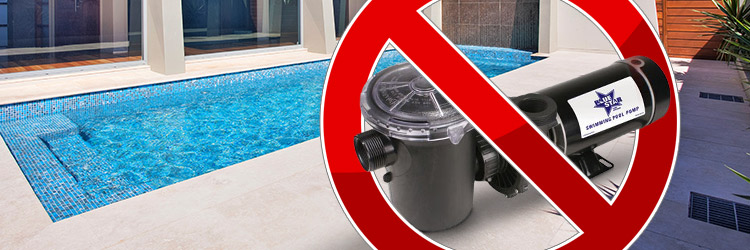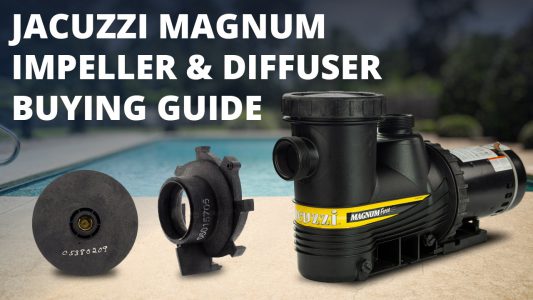Short Answer: No
The Long Answer:
What is it?
An impeller lock screw is a left handed thread screw used to secure an impeller to the shaft of a motor. When it was introduced, it was a vital part and the only thing keeping your impeller from a Tasmanian Devil-like path of destruction through the inside your pump.
Why don’t I need it?
Impeller lock screws have been slowly phased out of pump designs due to the industry wide switch to external thread motor shafts. The new design of motor shafts allows the stem of the impeller to thread onto the shaft. The reverse thread of the impeller stem means as the motor turns it is constantly tightening the impeller.
Old motors had an internal thread shaft tip without an external thread making the lock screw absolutely necessary. The new impeller and shaft design have left the screw in a state of obsolescence not seen since we stopped using answering machines or Service Merchandise.
Most pool owners do not realize the screw exists until the pump is back together and there is a leftover screw rolling on the ground. Leftover parts that serve no real purpose in the effectiveness of the design other than to confuse the builder after construction is complete is something we call the IKEA effect.

Are you sure I don’t need it?
Ok, there is only one instance in which the lock screw would still be necessary but the manufacturer states the chances of this are so remote they normally do not bring it up.
And I quote directly from the manufacturer, “the locking screw left over after an existing permanent split capacitor (PSC) pool or spa motor with an internally threaded shaft is replaced with a capacitor start motor without the internal shaft threading. Once the impeller is tightened onto the shaft of the new motor, the locking screw cannot be reinstalled. This situation naturally causes concern for some pool service professionals who question whether or not the impeller might somehow spin free. “
If you are still reading this then I congratulate you on being the foremost expert on impeller lock screws on your block. If your lock screw curiosity has not been cured or there is a different pool problem irking you, please give us us a call at 877-372-6038. We love to help!











Can the reverse thread screw be over tightened? I just replaced my Pentair WhisperFlo and the pump is running with less power, sluggish. And there is a a lot of heat coming from the pump.
The impeller screw is not going to cause water flow issues. If you believe the screw is causing the problem, remove it and run the pump without it to see if the problem fixes itself. The WhisperFlo impeller threads onto the motor shaft, so the screw is redundant. I’d give this guide a read to see if you can figure out why your pump has low pressure: How to Correct Low Water Pressure in Your Pool System
Thanks, this put me at ease. I have a variable speed motor and am positive at one time there was an impeller screw (certainly on the old fixed speed motor), but during maintenance this time, I found no screw. I came to the conclusion it must have been sucked into the filters and stuck in them when I replaced them, because screws don’t evaporate. The impeller screws on tight and the idea of adding teflon tape would make it impossible to spin off even if sudden braking and centrifugal force were a possibility. I had been looking all over the web for one and had never found one that would fit my motor..,.
I replaced my old motor in my Whisperflo with a Century Pro motor that has external threads in the shaft and does not accept the OEM reverse thread locking screw. Can I just hand tighten the impeller on the shaft and hope for the best? My concern is that without the reverse thread screw in place, there is a hole through the middle of the impeller that was previously closed via placement of the screw in the old setup. Should I purchase a new impeller that doesn’t have the reverse screw?
As the article states, you will be completely ok without the impeller screw.
The screw has no other purpose other than as a redundancy in the WhisperFlo design.
Without being able to use the screw, do you think the empty through-hole in the impeller that was once sealed by the screw and gasket will pose a problem? Do I need to fill it with silicone RTS? Or just leave it alone? Thanks.
Leave it alone.
The impeller hole is blocked by the motor shaft. The impeller is tightly locked in place and constantly being tightened by the spinning direction of the impeller. If you want to make extra super sure no water leaks use a turn of Teflon tape on the motor shaft threads.
I realize this is a very old post, but in a case like yours, I believe teflon tape or blue threadlocker would be essential – not for holding the impeller onto the shaft, but for water sealing, as you suggested.
The threaded interface between the shaft and the impeller would not be watertight, leaving a pathway for water and/or air to bypass the “shaft seal” (which technically only seals the impeller to the seal plate) thus creating a potential for a small leak.
If that were not the case, then the lock screw would not have its own rubber seal.
For specific context, I am currently rebuilding my Pentair Whisperflo WFE-4 with new motor bearings and all new seals, and I discovered that the screw was apparently left out during a previous rebuild (previous homeowner).
I agree that the screw is likely not needed to “lock” the impeller, but I do wonder if a small leak there could be the reason why my front bearing went out. Obviously, it could have just been a worn shaft seal, but it’s worth considering.
In my case, rather than the teflon tape or threadlocker, I grit my teeth and ponied up the $12 (for one little screw!) and ordered a new screw on Amazon (oh well, the next-day shipping was worth at least $10 to me anyway).
If I were replacing the motor with one that doesn’t accept a screw, I would use teflon tape or thread locker, or just replace the impeller while I’m at it.
Thanks Eric for sharing your thought.
I just received replacement motor (century 1 1/2 hp 48Y) and found out that left-threaded bore at shaft center is missing. My pump is Waterway SMF and discovered its impeller and backplate design is somewhat weird in that ceramic seal and metal gasket placement is revered. For my impeller I would need left-hand ‘lock’ screw to tighten the rubber gasket just like Whisperflow.
I would try teflon tape but it would only work if the external thread is tapered, which I suspect it is because otherwise ‘self-tightening’ of impeller won’t work. If it doesn’t work I may have to ‘plug’ the hole..
Maybe I am not grasping the picture you are laying out, but I don’t see why a turn of Teflon tape on the external motor shaft threads wouldn’t work. Regardless of the shaft seal orientation, if if it is installed correctly, water would only be able to (possibly) enter from the hole left vacant from the missing lock screw. The motor to impeller threads should be tight enough by themselves to prevent any leakage, but the water slinger at the hilt of the shaft should prevent water from entering the motor too. The internal thread hole on a shaft motor doesn’t extend all the way down the shaft.
Ok, so I have a Pentair Whisperflo XF I replaced the motor with a new one and used the existing impeller setup. I tightened down the impeller and also used the included inverse thread lock screw. the next day someone else tested the pump and said that the impeller unscrewed and shoved into the diffusor breaking both. The claim was that the motor was running the wrong rotation and that it unthreaded the impeller. With the lock screw installed is that even possible?
Did they explain how the motor was able to turn the incorrect direction? if it was a single phase motor, I am not sure how that would happen, even it was a variable speed.
Let’s say you overtightened the impeller, messing up the treads or cracking it enough to cause it to come loose. That might explain how the impeller was able to fly off.
It is a three phase motor, according to them the motor was wired to run the opposite direction which unthreaded the impeller. I am confused at this explanation though because there was a lock nut installed that threaded directly into the motor shaft and should have held the impeller in place regardless of rotation. Or am I missing something. The impeller has a metal thread insert. and a side question. If an impeller is rotating the opposite or “wrong” direction would that effect water flow?
When I say lock nut i meant to say impeller screw
Great summary. Concise, but also funny.